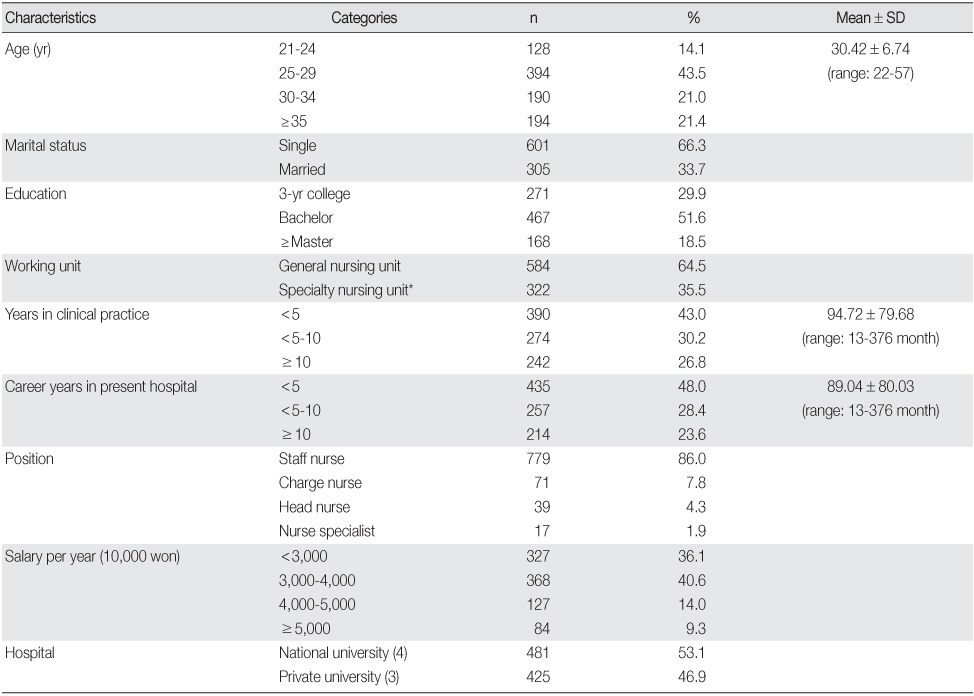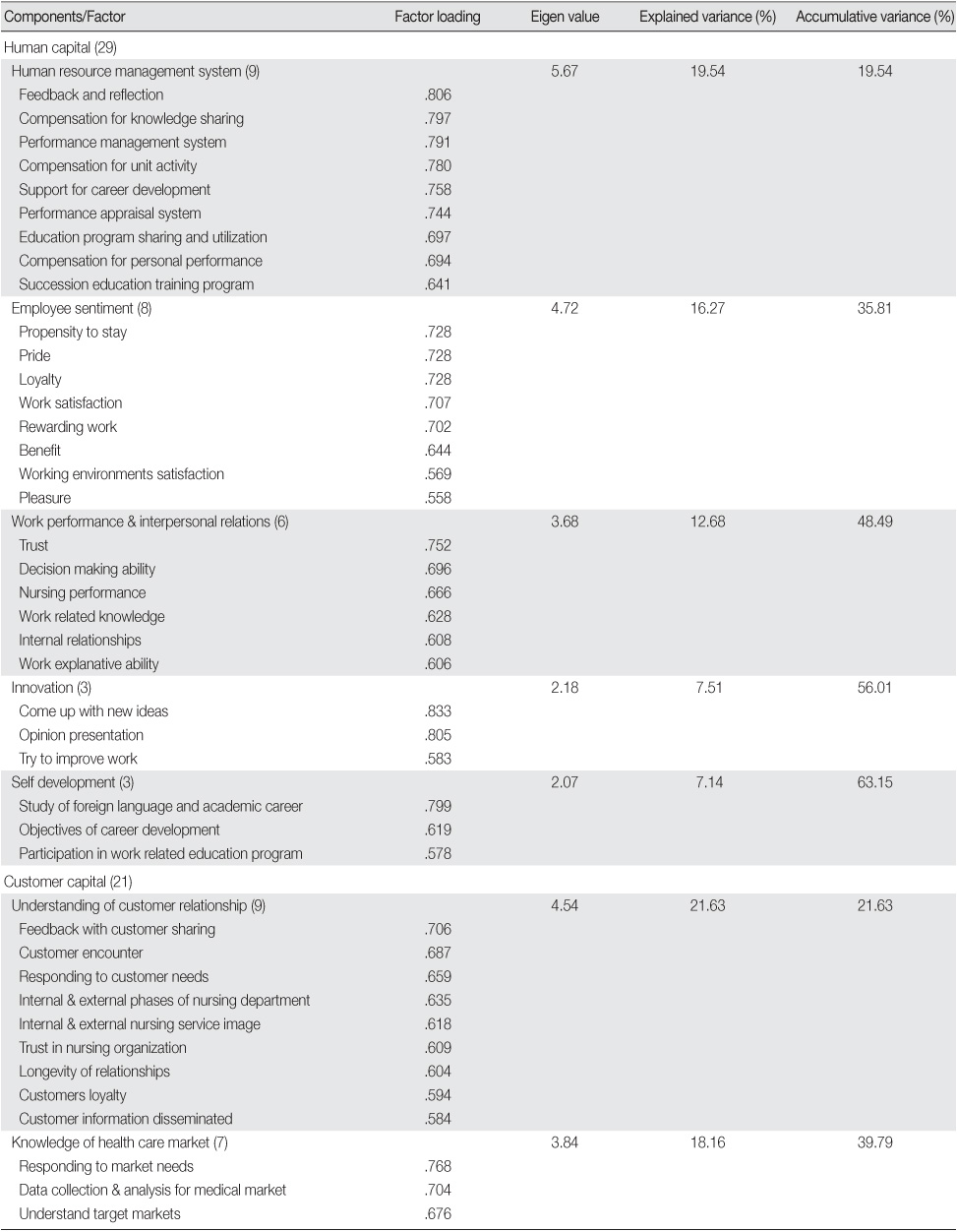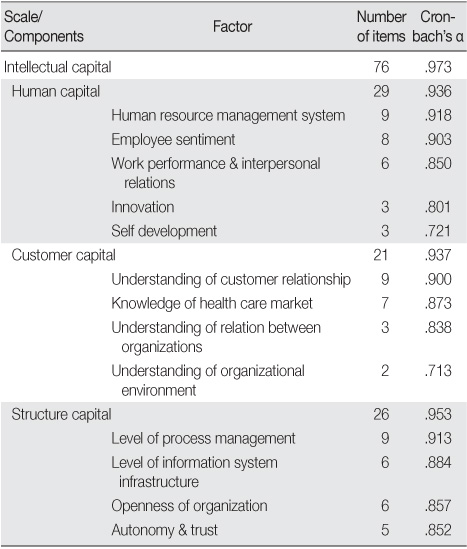Articles
- Page Path
- HOME > J Korean Acad Nurs > Volume 41(1); 2011 > Article
-
Original Article
- Development of a Measurement of Intellectual Capital for Hospital Nursing Organizations
- Eun A Kim, Keum Seong Jang
-
Journal of Korean Academy of Nursing 2011;41(1):129-140.
DOI: https://doi.org/10.4040/jkan.2011.41.1.129
Published online: February 28, 2011
1Nurse, Kidney Center, Chonnam National University Hospital, Gwangju, Korea.
2Professor, College of Nursing, Chonnam National University · Chonnam Research Institute of Nursing Science, Gwangju, Korea.
- Address reprint requests to: Jang, Keum Seong. College of Nursing, Chonnam National University, 5 Hak-dong, Dong-gu, Gwangju 501-190, Korea. Tel: +82-62-530-4955, Fax: +82-62-225-3307, jangks@chonnam.ac.kr
© 2011 Korean Society of Nursing Science
Abstract
-
Purpose
- This study was done to develop an instrument for measuring intellectual capital and assess its validity and reliability in identifying the components, human capital, structure capital and customer capital of intellectual capital in hospital nursing organizations.
-
Methods
- The participants were 950 regular clinical nurses who had worked for over 13 months in 7 medical hospitals including 4 national university hospitals and 3 private university hospitals. The data were collected through a questionnaire survey done from July 2 to August 25, 2009. Data from 906 nurses were used for the final analysis. Data were analyzed using descriptive statistics, Cronbach's alpha coefficients, item analysis, factor analysis (principal component analysis, Varimax rotation) with the SPSS PC+ 17.0 for Windows program.
-
Results
- Developing the instrument for measuring intellectual capital in hospital nursing organizations involved a literature review, development of preliminary items, and verification of validity and reliability. The final instrument was in a self-report form on a 5-point Likert scale. There were 29 items on human capital (5 domains), 21 items on customer capital (4 domains), 26 items on structure capital (4 domains).
-
Conclusion
- The results of this study may be useful to assess the levels of intellectual capital of hospital nursing organizations.
This article is based on a part of the first author's doctoral thesis from Chonnam National University.
- 1. Barbara HM. Statistical methods for health care research. 2001;4th ed. Philadelphia, NY, Lippincott-Williams and Wilkins.
- 2. Bontis N. Intellectual capital: An exploratory study that develops measures and models. Management Decision. 1998;36:63–76.Article
- 3. Bontis N, Fitz-enz J. Intellectual capital ROI: A causal map of human capital antecedents and consequents. Journal of Intellectual Capital. 2002;3:223–247.Article
- 4. Burns N, Grove SK. The practice of nursing research: Conduct, critique & utilization. 2005;5th ed. St. Louis, MO, Elsevier & Saunders.
- 5. Cabrita M, Vaz J. Intellectual capital and value creation: Evidence from the Portuguese banking industry. The Electronic Journal of Knowledge Management. 2006;4:11–20.
- 6. Castro GM, Sáez, PL. Intellectual capital in high-tech firms: The case of Spain. Journal of Intellectual Capital. 2008;9:25–36.
- 7. Covell CL. The middle-range theory of nursing intellectual capital. Journal of Advanced Nursing. 2008;63:94–103.ArticlePubMed
- 8. Hall LM. Nursing intellectual capital: A theoretical approach for analyzing nursing productivity. Nursing Economics. 2003;21:14–19.PubMed
- 9. Hwang US. The relationship of organizational effectiveness with core factors in knowledge management: Focused on hospital organization. 2001;Kyungbuk, Taegu University Korea. Unpublished doctoral dissertation.
- 10. Jang KS. A study on establishment of clinical career development model of nurses. 2000;Seoul, Yonsei University. Unpublished doctoral dissertation.
- 11. Kang SM. Intellectual capital and performance. 2007;Paju, Korean Studies Information.
- 12. Kim DH, Kim JH, Cho JS. A study on the construction of intellectual capital-based management system in R&D organization. Entrue Journal of Information Technology. 2008;7:33–49.
- 13. Kim KJ, Chung BK. A study on the impact of intellectual capital on the innovative behavior: Focused on the moderating effect of psychological capital. Saengsanseongnonjip. 2008;22:25–47.Article
- 14. Kim SM, Kang JS, Park HB. The relationship between intellectual capital and organizational performance in government organization. Korean Public Administration Quarterly. 2002;14:893–915.
- 15. Kym H, Kang YS, Jeong SH. The impact of intellectual capital on firm performance: An empirical study. Knowledge Management Research. 2003;4:35–54.
- 16. Moon YJ, Kym H. Towards an realistic framework for intellectual capital: Conceptual classification and assessment of components. Journal of Business Research. 2007;22:379–409.
- 17. Muchinsky PM. Emotions in the workplace: The neglect of organizational behavior. Journal of Organizational Behavior. 2000;21:801–806.Article
- 18. Lee DY. A study on the relation among knowledge assets, knowledge sharing, and organizational effectiveness. 2007;Jeonju, Chonbuk National University. Unpublished doctoral dissertation.
- 19. Lee EH. A method for the development and validation of an instrument. Korean Journal of Nursing Query. 2005;14:73–87.
- 20. Lee EH, Seo CS, Choi BW. An empirical study on the relationship between the components of intellectual capital. Journal of Human Resource Management Research. 2006;13:135–154.
- 21. Lee HJ, Cha YJ. A study on the influence of organizational culture on the knowledge management: With focus on the central government officials' perceptions. Korean Policy Sciences Review. 2007;11:105–128.
- 22. O'Dell C, Grayson J. If only we knew what we know: Identification and transfer of internal best practice. California Management Review. 1998;40(3):154–174.ArticlePDF
- 23. Park HB, Kang JS, Kim SM. The creation of social capital and intellectual capital, and their effects on organizational performance management. Korea Public Administration Journal. 2003;12:3–36.
- 24. Peng TJ, Pike S, Roos G. Intellectual capital and performance indicators: Taiwanese healthcare sector. Journal of Intellectual Capital. 2007;8:538–556.Article
- 25. Polit DF, Beck CT. The content validity index: Are you sure you know what's being reported? Critique and recommendations. Research in Nursing and Health. 2006;29:489–497.ArticlePubMed
- 26. Polit DF, Beck CT, Owen SV. Is the CVI an acceptable indicator of content validity? Appraisal and recommendations. Research in Nursing and Health. 2007;30:459–467.ArticlePubMed
- 27. Roos J, Roos G, Dragonetti NC, Edvinsson L. Intellectual capital: Navigating the new business landscape. 1997;London, Macmillan Business.
- 28. Weston MJ, Estrada NA, Carrington J. Reaping benefits from intellectual capital. Nursing Administration Quarterly. 2007;31:6–12.ArticlePubMed
- 29. Yi HG, Suh CH, Seo JH. A study on the effects of the competitive advantage and financial performance in organization's consists of intellectual capital factors. Korean Journal of Human Resources Development. 2003;5:38–66.
- 30. Youndt MA, Snell SA. Human resource configurations, intellectual capital, and organizational performance. Journal of Managerial Issues. 2004;16:337–360.
REFERENCES
Figure & Data
REFERENCES
Citations

- Evaluating private hospital performance from intellectual capital and digital perspective
Xiaoming Chen, Xin Shan, Jian Xu
Medicine.2024; 103(51): e41086. CrossRef - PERSONEL GÜÇLENDİRME İLE ENTELEKTÜEL SERMAYE ARASINDAKİ İLİŞKİNİN BELİRLENMESİ
Gülhan Gök
Dicle Üniversitesi İktisadi ve İdari Bilimler Fakültesi Dergisi.2024; 14(28): 1035. CrossRef - Perception of Importance of Patient Safety Management, Patient Safety Culture and Safety Performance in Hospital Managerial Performance of Hospital Nurses
Mi Yeon Park, Eun A Kim
Journal of Korean Academy of Nursing Administration.2018; 24(1): 40. CrossRef - Intellectual Capital and Organizational Effectiveness of Nurses: Comparison of Public and Private Hospitals
Jeong-Eun Oh, Gyeong-Suk Jeon, Kwang-Sim Jang
The Korean Journal of Health Service Management.2018; 12(2): 27. CrossRef - Effects of Intellectual Capital on Organizational Performance of Nurses in Medium and Small Hospitals
Won-Kyung Kim, Hyang-In Cho Chung
Journal of Korean Academy of Nursing Administration.2012; 18(4): 452. CrossRef
General Characteristics (N=906)
*Specialty nursing unit = ICU (intensive care unit), ER (emergency room), DR (delivery room), OR (operation room), OPD (out patient department). Nurse specialist. Neonatal nursing unit. out patient special unit.
Results of Factor Analysis for Intellectual Capital
Internal Reliability of Intellectual Capital Scale (N=906)
*Specialty nursing unit = ICU (intensive care unit), ER (emergency room), DR (delivery room), OR (operation room), OPD (out patient department). Nurse specialist. Neonatal nursing unit. out patient special unit.
 KSNS
KSNS
 E-SUBMISSION
E-SUBMISSION



 Cite
Cite

